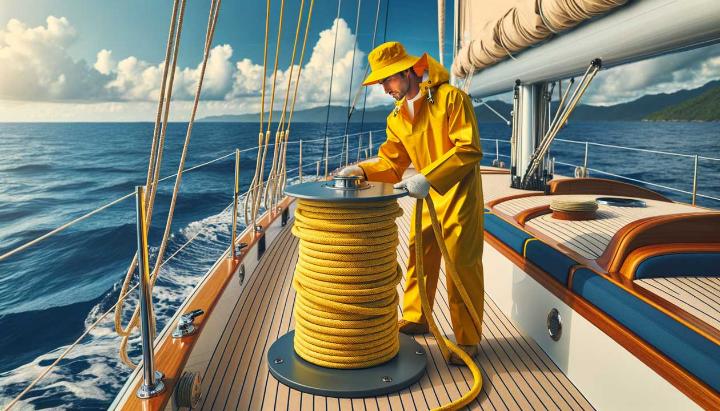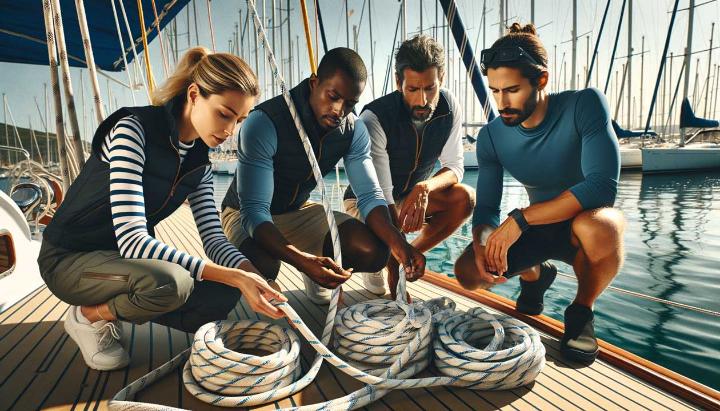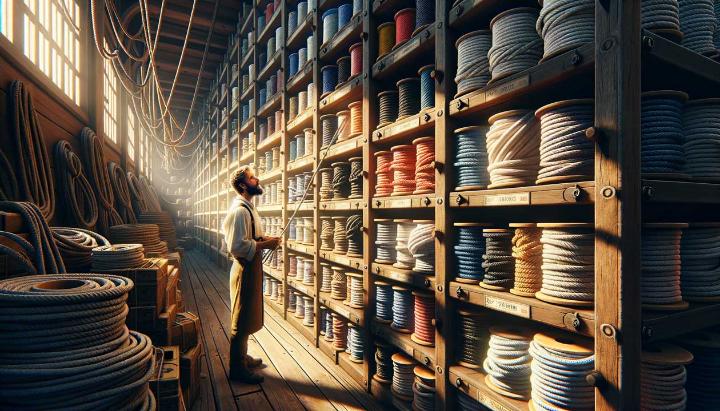Imagine yourself gliding effortlessly across the glittering waters, the gentle breeze caressing your sails as you navigate the open seas. In these moments of pure nautical bliss, every detail matters – including the ropes that tether your vessel to safety and control. Among the multitude of rope options, one stands out as a true seafarer's companion: the humble yet mighty three-strand rope braid.
Crafted with precision and ingenuity, these braided wonders intertwine three strands into a sturdy, resilient whole, offering the perfect balance of strength, durability, and versatility that every yachting enthusiast craves. Whether you're anchoring in a secluded cove or taming the winds with deft line handling, a well-chosen three-strand rope braid can elevate your maritime adventures to new heights.
In this comprehensive guide, we'll delve into the fascinating world of braided ropes, unraveling the secrets behind their construction and exploring the myriad benefits that make three-strand braids the ideal choice for yachting. From understanding their unique structure to mastering the art of selection and maintenance, you'll gain invaluable insights to help you navigate the high seas with confidence and style.
Understanding the Structure of Braided Ropes
Braided ropes are a marvel of engineering, intertwining strands of fibers into a sturdy, flexible, and dependable workhorse. Imagine each strand as an individual thread, woven together with precision to create a robust and resilient whole.
Braided Rope Construction
The magic of braided ropes lies in their construction process. Strands of materials like nylon, polyester, or high-modulus polyethylene (HMPE) are skillfully interlaced in a circular or tubular pattern. This intricate weaving technique ensures even distribution of load and stress, resulting in superior strength and durability.
Double-braided ropes take this concept a step further by encasing an inner core with an outer braided jacket. This design not only enhances load-bearing capabilities but also provides excellent abrasion resistance, making these ropes ideal for heavy-duty applications.
On the other hand, hollow braided ropes feature a hollow core, offering a unique combination of flexibility and lightweight construction. These ropes excel in scenarios where compact size and maneuverability are paramount.

Types of Braided Ropes
The world of braided ropes is vast and varied, catering to diverse needs and applications. From heavy-duty HMPE ropes renowned for their exceptional strength-to-weight ratio to specialized diamond braid ropes prized for their resistance to snag and abrasion, the options are plentiful.
At the heart of this article, however, lies the humble yet mighty 3-strand braided rope. With its simple yet effective design, this rope offers a perfect balance of performance and versatility, making it an indispensable tool for yachting enthusiasts.
The Benefits of Using a 3-Strand Rope Braid for Yachting
The versatile allround sheet, ideal for use as a halyard, sheet, or trim line,
excellent value for money.
MATERIAL: nylon 66
CONSTRUCT: 3-strands
ELONGATION: 35%
Whether you're cruising the open waters or docking at a picturesque marina, the right rope is an essential companion for any yachting adventure. Among the myriad choices available, the humble yet reliable 3-strand rope braid stands out as a true workhorse, offering a unique blend of strength, durability, and versatility that every seafarer can appreciate.
Strength and Durability of 3-Strand Braids
Imagine each strand as an individual thread, woven together with precision to create a robust and resilient whole. This simple yet ingenious construction is the secret behind the exceptional strength of 3-strand rope braids. With their twisted design, these ropes are able to evenly distribute loads and withstand immense forces, making them an excellent choice for anchoring, mooring, and other high-stress applications.
But strength is just one part of the equation. What truly sets 3-strand braids apart is their remarkable durability. Crafted from durable materials like nylon, polyester, or high-modulus polyethylene (HMPE), these ropes are built to withstand the harsh marine environment, resisting wear, abrasion, and the relentless onslaught of sun, salt, and water.
Unlike their braided counterparts, 3-strand ropes also boast an impressive resistance to stretching and deformation, ensuring a consistent performance even under heavy loads. This elastic property not only enhances their longevity but also helps absorb shocks and sudden jerks, providing an added layer of safety for your vessel and crew.

Splicing and Handling Advantages
One of the greatest advantages of 3-strand rope braids lies in their ease of splicing. Unlike their more complex braided counterparts, these ropes can be easily spliced with minimal effort, allowing you to create custom lengths, loops, and terminations tailored to your specific yachting needs. Proper splicing not only enhances the rope's performance but also extends its lifespan, ensuring you get the most out of your investment.
But the benefits don't stop there. 3-strand braids are also renowned for their exceptional handling characteristics. With their flexible yet sturdy construction, these ropes are less prone to kinking and tangling, making them a breeze to work with on deck. Whether you're coiling them for storage or running them through pulleys and cleats, the 3-strand braid's smooth surface and pliable nature ensure a seamless experience.
From anchoring and docking lines to mooring and towing applications, the versatility of 3-strand rope braids makes them an indispensable asset for any yachting enthusiast. So, why settle for anything less than the perfect balance of strength, durability, and user-friendliness that these ropes offer?
Choosing the Right Rope Braid with 3 Strands
In the world of yachting, where strength, durability, and performance are paramount, selecting the right rope is a decision that can make or break your nautical adventures. That's why choosing the perfect 3-strand rope braid is an essential step for any seafarer worth their salt.
Benefits of 3-Strand Ropes
Before we dive into the nitty-gritty of choosing the ideal 3-strand rope, let's take a moment to appreciate the unique advantages these braided beauties offer:
- Superior strength and durability - With three strands woven together in a tight braid, these ropes can withstand immense loads and resist wear and tear, ensuring they'll be your trusty companions for years to come.
- Excellent grip and handling - The braided texture provides a reliable grip, even in wet conditions, making it easier to handle and secure lines with confidence.
- Resistance to stretching and deformation - Unlike some of their more elastic counterparts, 3-strand braids maintain their shape and length under heavy loads, ensuring consistent performance.
- Versatility across yachting applications - From anchoring and mooring to towing and general deck work, these ropes are the true workhorses of the sea.
Types of 3-Strand Rope Braids
Just like the diverse array of vessels gracing the oceans, 3-strand rope braids come in various forms to suit different preferences and needs. Here are a few common types you might encounter:
- Twisted 3-strand ropes - These classic braids feature three strands twisted together, creating a round, sturdy rope with a traditional look and feel.
- Braided 3-strand ropes - Instead of twisting, the strands are woven together in a more intricate pattern, resulting in a smoother surface and enhanced grip.
- Hollow braided 3-strand ropes - As the name suggests, these ropes have a hollow core, making them lighter and more flexible while still maintaining their strength.

Each type offers its unique advantages, so it's essential to consider your specific yachting needs when making your selection.
Applications and Uses of 3-Strand Ropes
The versatility of 3-strand rope braids is one of their greatest strengths, making them suitable for a wide range of yachting applications. From anchor rodes and docking lines to towing ropes and general deck work, these ropes have you covered.
When choosing a 3-strand rope, consider factors such as the intended use, load requirements, and environmental conditions. For instance, a thicker, more durable rope might be ideal for anchoring or mooring in rough waters, while a lighter, more flexible option could be better suited for general deck work.
Remember, investing in high-quality 3-strand ropes not only ensures optimal performance but also contributes to the safety and longevity of your yachting adventures. For more detailed guidance, refer to our Mastering Splicing Nylon and Dyneema Rope Techniques guide.
Customization Options for Personalized Strands of a Rope
One of the greatest advantages of 3-strand rope braids is the ability to customize them to suit your specific needs and preferences. Many reputable manufacturers offer a range of customization options, allowing you to create a truly personalized rope that not only performs exceptionally but also reflects your unique style.
From selecting the material (nylon, polyester, or HMPE) to choosing the diameter, length, and color scheme, the possibilities are endless. You can even explore specialized performance features like UV resistance, reflective elements, or glow-in-the-dark coatings for enhanced visibility and safety. For more ideas on customization, visit our customization page.
Don't settle for off-the-shelf solutions when you can have a rope that's tailored to your exact specifications. Embrace the art of customization and elevate your yachting experience with a truly one-of-a-kind 3-strand rope braid.
Maintaining and Caring for Your 3-Strand Braided Rope
When it comes to yachting, having the right rope is just the beginning. To ensure your trusty 3-strand braid remains a reliable companion on the high seas, proper maintenance and care are essential. Just like a well-tuned engine or a pristine hull, your rope deserves the utmost attention to keep it in top condition, voyage after voyage.
Proper Storage of 3-Strand Braided Ropes
Imagine the chaos of a frayed, tangled rope when you need it most. To avoid such nightmares, start by storing your 3-strand braided ropes in a cool, dry, and well-ventilated area, away from direct sunlight and extreme temperatures. Excessive heat or moisture can wreak havoc on the fibers, compromising the rope's integrity and strength.
Invest in dedicated rope bags or containers to keep your braids safe from dirt, debris, and potential contaminants. But remember, these ropes need to breathe, so avoid sealing them in airtight containers. A little air circulation goes a long way in preserving their longevity.

Cleaning and Drying 3-Strand Braided Ropes
Salt, grime, and the remnants of your latest adventure can take a toll on your rope's appearance and performance. But fear not, a gentle cleaning routine can work wonders. For synthetic fiber ropes, mix a mild soap or detergent with room-temperature water and gently agitate the rope. Avoid harsh scrubbing or chemical cleaners, as these can damage the delicate fibers.
If you're dealing with a natural fiber rope, such as manila or sisal, keep it dry to prevent rotting. After cleaning, thoroughly air-dry your rope, allowing it to soak up the warm rays of the sun. For an extra touch of softness and flexibility, consider using a diluted fabric softener during the drying process.
Avoiding Abrasion and Damage to 3-Strand Braided Ropes
Dragging your rope over rough surfaces or dirty grounds is a surefire way to invite abrasion and fiber damage. Treat your 3-strand braid with care, avoiding kinks, twists, or excessive tension that could open the strands and compromise its integrity.
Regular inspections are crucial for identifying signs of wear, such as fraying or broken strands. If you notice any concerning areas, it's better to be safe than sorry – replace the rope promptly. In high-friction areas, consider using protective chafe gear or sleeves to shield your braid from sharp edges or abrasive surfaces.
Remember, a well-maintained 3-strand braided rope is not only a joy to handle but also a vital safety component on your vessel. By following these simple guidelines, you can ensure your rope remains a trusted ally, ready to tackle any nautical challenge that comes your way. If you need more information on rope maintenance, explore our Mastering Rope Splice Techniques for Nylon and Winch Ropes guide.
A well-crafted rope braid with 3 strands is essential for mastering yachting. These ropes combine exceptional strength, durability, and flexibility, making them ideal for various maritime applications. Constructed by twisting strands of a rope, they offer enhanced resistance to stretching and deformation, benefiting anchoring and mooring activities. Customization options allow for tailored materials, diameters, and lengths, ensuring optimal performance. Proper maintenance, including storage, cleaning, and regular inspection, further extends the lifespan of these ropes. Investing in high-quality, custom 3-strand ropes is a surefire way to elevate your seafaring experience and guarantee safety.
Discover the Ideal 3-Strand Rope Braid for Your Yachting Needs
Ready to enhance your yachting adventures with the perfect 3-strand rope braid? Fill in the form above, and let us provide you with a custom solution that meets your specific needs.